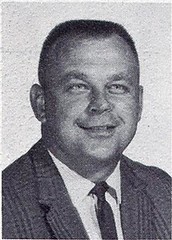One day after lunch when I was in fifth grade, in about 1962, Mr. Peter told his class that he had a surprise to show us. He led us our class and a couple other classes out of the school, and we all walked down Faculty Lane to the football stadium and then up onto East Field.
Earlier that day, some workers were digging for some reason on East Field, and they found some old coffins buried in the ground. The sensational news about this discovery then spread like wildfire and reached St. John's by lunchtime. Therefore Mr. Peter immediately organized this excursion to East Field so that we all could see the dug-up graves before they were removed to some more restful location.
I think that the bodies already had been removed from the coffins, but the coffins and some clothing still remained in the holes that had been dug up. We were told that some Nebraska pioneers apparently had been buried there about a hundred years previously, and now their little, long-disappeared cemetery had been discovered.
We students looked at the empty coffins and scraps of old clothing and pondered our own mortality. We too might eventually be buried, and then our own gravesites might eventually disappear and be re-discovered a century or two in the future. If Judgement Day did not come first!
My brother Steve wrote:
I recall the day when we St. John School students went up to where the new CTC dorms were being excavated to see the bones that were unearthed. I vividly recall the outline of the pine box casket, and that there was still a tuft of hair on the skull. The conclusion spoken of that day was that the site was an abandoned pioneer cemetery of some sort. My memory is that there were two caskets unearthed. Perhaps it was a farmstead family cemetery, but maybe the burials were made by pioneers passing through the area.
The haunting referred to at the link below suggests that the area was once an Indian burial ground. If that is true, my understanding is that Indians consider their burial grounds to be sacred places. If that is so in this case, then there might have been some difficult times in the area of the CTC campus when white people first started to appear in the area.
Now that I (Mike) have read Steve's memory, I too confirm that we could see a skull with some tufts of hair. I did remember that from the beginning, but I thought that they would not show us kids a dead body, so I decided that the bodies must have been removed before we kids came. But, Steve is right, we did see the dead bodies.
Steve provided this link to another website about haunted places, which says:
Concordia University-David DormLocated at 800 N. Columbia Ave. in Seward, Nebraska.
The History:
This is a Christian college that is affiliated with the Lutheran Church. It serves approximately 1500 students. It was founded in 1894 as Concordia Teacher's College. During World War I, the school was subject to some anti-German regards. Women were admitted to the college for the first time after World War I, but they had to live off-campus. Finally in 1932 they were permitted in the dining hall and then in 1941, the first women's dormitory was constructed.
David Dorm was purportedly built in the 1970's and bones were discovered at the building site, most likely those of Native Americans. The bones were turned over to researchers and were discovered to apparently date back to the 1700's. Permission was granted by the city of Seward, to continue building on the site, but all the remains discovered at the location had to be turned over.
The Haunting:
Electrical equipment will occasionally turn on or off without explanation.
Observations:
Native American burial grounds are often associated with reports of paranormal activity, as are colleges and universities. In fact, dormitories are the most likely location to be reported as a site of paranormal activity. The fact that David Dorm was built on an Indian burial ground definitely adds to the story and makes the claims of paranormal activity quite a bit more interesting.


No comments:
Post a Comment